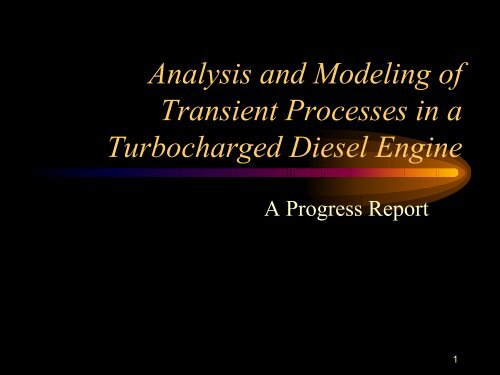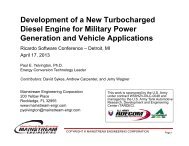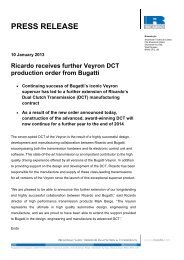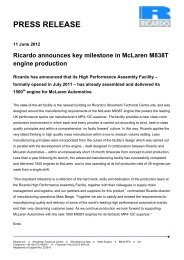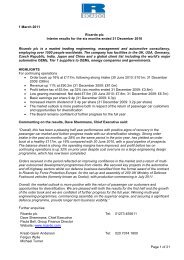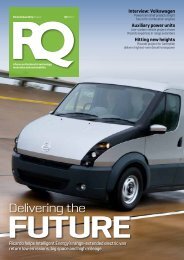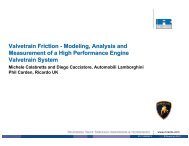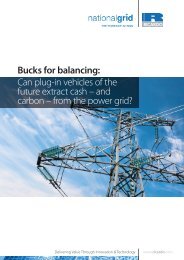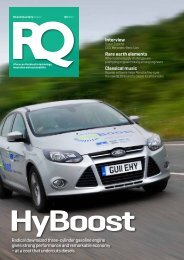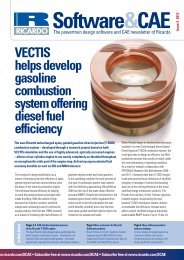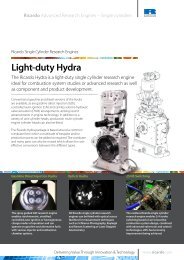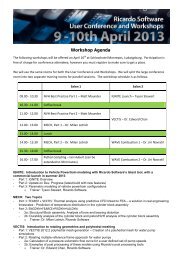Analysis and modeling of transient operation of ... - Ricardo
Analysis and modeling of transient operation of ... - Ricardo
Analysis and modeling of transient operation of ... - Ricardo
Create successful ePaper yourself
Turn your PDF publications into a flip-book with our unique Google optimized e-Paper software.
<strong>Analysis</strong> <strong>and</strong> Modeling <strong>of</strong><br />
Transient Processes in a<br />
Turbocharged Diesel Engine<br />
A Progress Report<br />
1
Outline<br />
• Motivation<br />
• Objectives<br />
• Philosophy/Requirements<br />
• Model development<br />
• Experimental Setup<br />
• Engine variants<br />
• Testing <strong>and</strong> instrumentation
Motivation<br />
• Modern turbocharged diesel engine’s <strong>transient</strong> response<br />
integrates the unsteady contribution <strong>of</strong> processes taking<br />
place in several engine subsystems <strong>and</strong> components that<br />
may have their own dynamics<br />
• Traditionally engine <strong>transient</strong> behavior has been<br />
characterized in terms that pointed either to a single<br />
component (turbolag), or to the engine as a whole (load<br />
acceptance, smoke limit, driveability, etc)<br />
• If one admits that there are many factors influencing the<br />
speed <strong>transient</strong> it may consider useful to examine in<br />
details each subsystem <strong>and</strong> process responsible for<br />
<strong>transient</strong> behavior
Objectives<br />
“turbo-lag”, “compresso-lag” or “?-lag”?<br />
• Define engine <strong>transient</strong> processes, detailed at the<br />
components level identify the critical processes in<br />
subsystems responsible for delaying acceleration<br />
• Assess the relative contribution <strong>of</strong> each particular process<br />
through simulation <strong>and</strong> experiment <strong>and</strong> establish<br />
interrelations<br />
• Identify patterns for undesirable response effects during<br />
<strong>transient</strong>s by observing consistent trends during<br />
acceleration steps <strong>and</strong> analyzing evolution <strong>of</strong> various<br />
processes <strong>and</strong> parameters in the sequence <strong>of</strong> cycles<br />
• Elaborate a more consistent definition for concepts such as<br />
“turbolag”
Philosophy, Requirements<br />
• Due to the relatively high complexity <strong>of</strong> processes to be<br />
examined a consistent methodology for conducting testing<br />
<strong>and</strong> simulations is highly dem<strong>and</strong>ed<br />
• Engine simulation does not necessarily aim to reduce or<br />
replace experiments, but to complement them by providing<br />
information on variables that are difficult to measure at the<br />
relevant time scale<br />
• The model should preserve the essential in-depth physical<br />
information but also provide useful results from an engine<br />
control perspective<br />
usually distinct approaches – involve different time scales
Simulation Approach<br />
• <strong>Ricardo</strong> Wave s<strong>of</strong>tware has been preferred for its<br />
versatility, efficient calculation, well tested <strong>transient</strong><br />
simulation capabilities <strong>and</strong> for being a highly accepted<br />
platform in the research community<br />
• A model <strong>of</strong> a 4 cylinder t/c engine has been set up <strong>and</strong><br />
calibrated in WAVE <strong>and</strong> ever since has been revised <strong>and</strong><br />
improved to accommodate new details as the study was<br />
advancing
Simulation related requirements<br />
• High versatility in selecting submodels<br />
• Use <strong>of</strong> Sensors/Actuators<br />
• Presence <strong>of</strong> external links at a time-step level<br />
• Capability to implement user code (– dynamic<br />
model for a turbine or compressor to override<br />
steady state maps)<br />
• Capability to define dynamic load application to<br />
match either braking by dyno or actual<br />
transmission
Experimental setup<br />
• Experiments were<br />
carried out on a<br />
commercial engine<br />
• Presence <strong>of</strong><br />
commercial ECU<br />
requires accurate<br />
control <strong>modeling</strong> <strong>and</strong><br />
hardware<br />
• Prototyping tools<br />
available.<br />
Daimler-Chrysler 2.5 l engine –<br />
developed by VM MOTORI (same series<br />
with the 2005 Jeep Liberty 2.8 l Diesel)
Daimler-Chrysler 2.5 l engine – Characteristics<br />
Speed range, rpm 1000-4000<br />
Rated power, kW 103 at 4000 rpm<br />
Maximum torque, Nm 340 at 2000 rpm<br />
Bore [mm]/ Stroke [mm] 92/94<br />
Connecting rod length [mm] 163<br />
Intake valve diameter [mm] 30.4<br />
Exhaust valve diameter [mm] 28.9<br />
Compression ratio 17.5:1<br />
Compressor inlet diameter [mm] 46<br />
Compressor outlet diameter [mm] 36<br />
Turbine inlet diameter [mm] 45<br />
Turbine outlet diameter [mm] 46<br />
IVO [c. a. deg.] 14 BTDC<br />
IVC [c. a. deg.] 44 ABDC<br />
EVO [c. a. deg.] 66 BBDC<br />
EVC [c. a. deg.] 32 ATDC<br />
Firing order 1-3-4-2<br />
Maximum common rail pressure [bar] 1350<br />
Maximum boost pressure [bar] 2.3<br />
Boost pressure limited by Wastegate valve<br />
upgrade<br />
VGT
Testing Facility – A/C DYNO<br />
AVL APA series 045<br />
Puma Open System
Engine Instrumentation<br />
PAO<br />
TAC<br />
PAI<br />
TAI<br />
Air<br />
Cooler<br />
PA<br />
TWI<br />
TA<br />
T/C-speed<br />
Cylinder pressure<br />
Needle-lift<br />
Water in<br />
PGT<br />
TEX<br />
TGO<br />
EGR Cooler<br />
Shaft encoder<br />
Common rail<br />
pressure<br />
TWO<br />
Water out<br />
Fuel mass<br />
flow meter<br />
Flexible engine controls<br />
• INCA VME module connecting the open ECU<br />
(ETK 7) ETAS s<strong>of</strong>tware VS100<br />
• RPECS –rapid prototyping engine control<br />
system
RPECS –rapid prototyping engine control system
Engine basic model
Model validation 2000 rpm, 150 Nm<br />
90<br />
80<br />
70<br />
60<br />
50<br />
40<br />
30<br />
20<br />
10<br />
0<br />
180 270 360 450<br />
Injection rate pr<strong>of</strong>ile
Next Steps<br />
• Investigate the correlation <strong>of</strong><br />
instantaneus t/c speed with the<br />
exhaust pressure variation<br />
• Effect <strong>of</strong> <strong>transient</strong> strategy<br />
– Effect <strong>of</strong> a late injection on T/C<br />
speed pick-up<br />
• Effect <strong>of</strong> improving <strong>transient</strong> to<br />
emissions, fuel economy<br />
• Effect <strong>of</strong> delay in fuel delivery,<br />
rail pressure built up


